AMCW-LAS (Amplitude Modulated Continuous Wave- Laser Absorption Spectrometer)
Airborne Sensors
AMCW-LAS (Amplitude Modulated Continuous Wave- Laser Absorption Spectrometer)
Overview
The AMCW-LAS instrument is an airborne active laser assembly of JAXA (Japan Aerospace Exploration Agency). The overall objective is to validate the CO2 observations of the spaceborne GOSAT (Greenhouse Gases Observing Satellite) mission of JAXA which was launched on January 23, 2009. The GOSAT spacecraft carries TANSO-FTS (Thermal And Near infrared Sensor for carbon Observation - Fourier Transform Spectrometer), an instrument which measures the global CO2 column abundances by passive remote sensing techniques. 1)
However, the global observation by passive means generally limits the observations because radiation into the observation instrument can only be obtained during the sunlit phase of the orbit; i.e., the total column can only be evaluated during daytime. In addition, the solar seasonal dependence reduces the global coverage in the northern hemisphere during winter time.
An active optical remote sensing technique, such as lidar, is a natural choice for a next generation spaceborne trace gas instrument, to improve the drawbacks of passive remote sensing. An airborne instrument assembly, such as AMCW-LAS, has the potential to obtain measurement accuracies of < 0.5%. Hence, the AMCW-LAS technique has been selected to demonstrate the CO2 column measurement technique for the next generation spaceborne mission - and to validate the observations of the GOSAT mission with corresponding underflights.
A wavelength of 1.57 µm is used to evaluate weighted column-averaged CO2 with the direct detection technique of AMCW-LAS (Amplitude Modulated CW - Laser Absorption Spectrometer). Figure 1 provides a functional block diagram of the assembly.
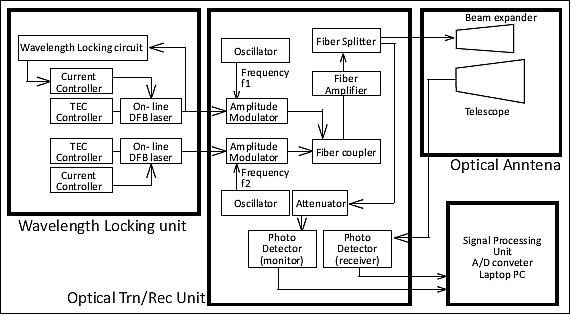
The system consists entirely of optical fiber circuits. The on-line and off-line sources are the CW laser diodes which are operating in the wavelengths of 1572.992 nm (or 6357.3116 cm-1) and 1573.193 nm (or 6356.4991 cm-1), as shown in Figure 2. The on-line wavelength is stabilized within root mean square (rms) of 12 MHz at the R(12) absorption peak in the (30012←00001) CO2 band. The other is stabilized within 48 MHz rms by controlling its temperature and injection current. Both line-width of laser sources are a few hundred kHz. The fiber-coupled outputs are amplitude modulated with electro-optical devices. The outputs are combined and amplified by a fiber amplifier. Almost all of the amplified power (99%) is transmitted by a beam expander.
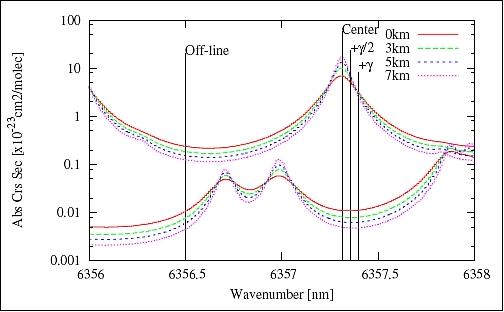
Legend to Figure 2: An optical length of 1 km along the horizontal path, a CO2 mixing ratio of 380 ppmv, an H2O mixing ratio of 20 g/kg, an atmospheric pressure of 1013 hPa, and a temperature of 300 K has been assumed. γ is the air-broadening coefficient. The relative interference from water vapor absorption for the differential optical depth of CO2 is less than 10-6.
The transmitted 1/e-beam diameter is 60 mm and the divergence half-angle is 60 µrad. The total transmitted power at the fiber end is 1.2 W. The residual 1% is monitored as a reference for receiving signals. The scattering signals from the target area are collected by a receiving telescope with a field of view of 0.2 mrad and a 110 mm active aperture. The signals are focused on a multi-mode fiber with a 200 µm core diameter, and detected with a 0.5 mm diameter InGaAs-PIN photodiode. The received signals are digitized by a high speed digitizer (60 MS/s, 12 bit). The wavelength identification and power evaluation are performed by a FFT (Fast Fourier Transform) on a laptop computer.
The system measures differential absorption optical depth (DAOD = τ) between the altitude (R) and the ground.

where:
- Prec, on, off is the laser power scattered at the target
- Pmon, on, off is the monitored laser power
- Cnst: is the constant as the instrumental offset
- Δφ is the phase difference between the monitored and the received signals
- T is the period of a modulated sinusoidal signal, and C is the speed of the light.
The specific term of “Cnst” is the automatically corrected value during measurements; this value is stable even if the surrounding environmental temperature is changed. The phase difference between the transmitted and received sinusoidal signals matches the range to a target. If the time of flight for the laser exceeds this period, then T changes into T + nT.
Transmitter | |
On-line | 6357.31113 cm-1 |
Off-line | 6356.49917 cm-1 |
Power | 1.2 W (fiber end) |
Stability | On/Off = 12/48 MHz |
Modulation | On/Off = 140/141 kHz |
Beam diameter | 60 mm |
Beam divergence | 0.12 mrad |
Receiver | |
Active diameter | 110 mm |
FOV (Field of View) | 0.2 mrad |
Detector | InGaAs-PIN |
Fiber core diameter | 200 µm |
Distinguish On/Off | FFT (Fast Fourier Transformation) |
Accumulated time | 2 s/pt |
A/D conversion | 60 Msample/s |
Data quantization | 12 bit |
Spectroscopic data | |
Center wavelength | 6357.31157 cm-1 (R(12)) |
Line intensity | 1.6613 x 10-23 ([cm-1/molec/cm-2) |
Air-broadening coefficient | 0.07781 cm-1/atm. |
Air-pressure shift coefficient | -4.30 x 10-3 cm-1/atm. |
Self-pressure shift coefficient | -4.82 x 10-3 cm-1/atm. |
Temperature dependence exponent of γ air | 0.695 |
Lower state energy | 60.8709 cm-1 |
Column-averaged XCO2
The analytical model assumes an aircraft platform to measure the light scattered or reflected by the ground or sea surface. Active remote sensing using the direct detection AMCW-LAS or a pulsed IPDA (Integrated Path Differential Absorption) lidar can measure the weighted optical depth of CO2. Extinction at an on-line wavelength results in a significantly larger atmospheric extinction than that for the off-line wavelength used as a reference. Considered as an intensity ratio of two scattering signals, the weighted column-averaged CO2 (XCO2) can be described by the following equation:
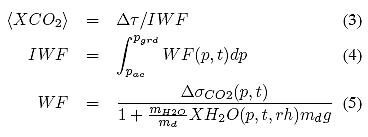
where:
- Δσ is the differential absorption cross section of interest trace gas between on- and off-line
- pac is the pressure at aircraft height
- pgrd is the surface pressure
- mH2O and md are the molecular mass of water vapor and of dry air
- XH2O is water vapor mixing ratio, and g is the gravity constant.
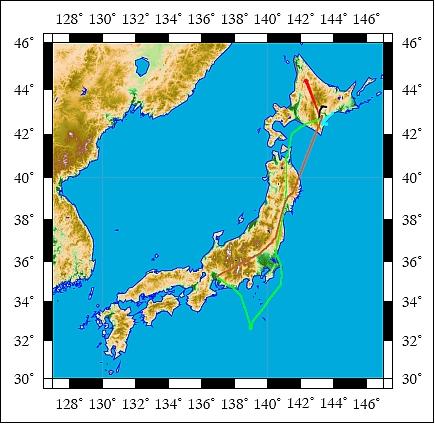
AMCW-LAS flight test campaigns
The first aircraft measurements to evaluate the weighted CO2 column were performed with flask sampling devices in August 2009. There were a total of six flights, all of them took place in the Hokkaido prefecture which is located on the northern most island of Japan.
The AMCW-LAS system observed the weighted column-averaged CO2 from the aircraft to the ground. The amplitude modulation frequencies were 10 kHz for the on-line, and 11 kHz for the off-line operations. The accumulation time was 2 s during the measurements. Additional 4 s were required to process the FFT. A visible CCD camera (Artray Inc. Model ArtCam 150pIII) also monitored the landscape under the aircraft in 5 s intervals. These sequential images were used for cloud cover detection over the land and the ocean.
The atmospheric CO2 was taken from 0.5 km to 7 km by the flask sampling and in-situ measurements. Unfortunately, the in situ measurement data were not good due to a gas leak. The CO2 mixing ratio obtained from flask sampling was used to validate the weighted column-averaged CO2.
The position of the aircraft was monitored using a GPS receiver. Additional information of the atmospheric temperature, pressure, ground speed and ellipsoid height were provided by the aircraft instruments. The complementary measurement with radiosondes was performed at the Moshiri observation site. In order to evaluate (XCO2), the integral of Equation 4 was carried out with the profiles of the atmospheric parameters; the actual parameters were used if a parallel radiosonde measurement was performed. The results of radiosondes were also used to evaluate the full column of the high resolution FTS measurements.
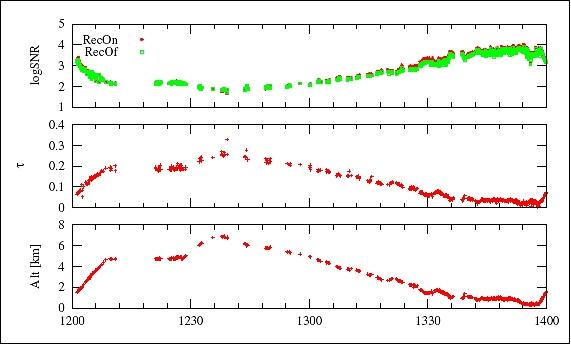
Results: Significant measured data of the AMCW-LAS instrument were performed from August 24 to 30, 2009. For the CO2 profiles, descent spiral flights were carried out at the Moshiri and Taiki observation sites as illustrated in Figure 3.
Figure 4 shows the logarithm of the on-line and off-line SNR, the differential absorption optical depth Δτ and the altitude from the ground over the Moshiri site after the cloud screening. The logarithm of the SNR is consistent with altitude and Δτ. The error due to the SNR of the return signal at an altitude of 3 km is 0.3%, after 30 points of averaging. The error at an altitude of 7 km increases to 1.2% due to a degenerated SNR.
Figure 5 illustrates the (XCO2) over the city and grassland on August 29, 2009. The (XCO2) value over the city of Obihiro, marked as red circles in this figure, is 381.2 ppm, whereas the value over the grass land, marked as blue circles, is 374.9 ppm. These data are evaluated using the mesoscale model data with the same integration range of Equation 4. The (XCO2) value over the city is larger than that over the grassland.
Although the measured (XCO2) value could not satisfy the requirement of the 1ppm relative accuracy, the realization of a more accurate system is obtainable under the current technology readiness level (TRL) for the laser and telescope. The required improvements to achieve 1 ppm relative accuracy are only the wavelength stability (less than 1 MHz) and receiving SNR (200 per 1 point). The current TRL is sufficiently mature to develop a pre-flight model for the next generation space mission.
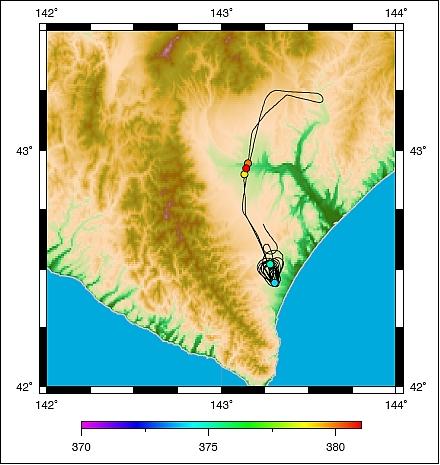
The accuracy of the range measurement is evaluated as 0.12%. The errors due to the meteorological data are 0.438% at a temperature uncertainty of 1 K, 0.02% at relative humidity uncertainty of 10% and 0.062% at atmospheric pressure uncertainty of 1 hPa. The error due to the operating wavelength instability was evaluated to be less than 0.576%. The bias error due to the spectroscopic data for the CO2 R(12) line is estimated to be 0.13%. The total relative errors at the altitudes of 3 km and 7 km are estimated to be less than 0.78%.
In summary, the aircraft measurements demonstrated the evaluation of the weighted column-averaged CO2 data using the 1.57 µm continuous laser-based direct detection AMCW-LAS instrument assembly. The weighted column-averaged CO2 of the AMCW-LAS indicates good agreement with the the calculated values obtained from flask sampling and radiosonde measurements. In addition, the results show that the difference of the CO2density over the city and grassland can be observed. The current laser and telescope technology are enough to realize the target accuracy of 1 ppmv relative accuracy.
Starting in February 2010, flights with the AMCW-LAS assembly were conducted to validate the TANSO-FTS data of the GOSAT mission.
References
1) D. Sakaizawa, S. Kwakami, H. Ohyama, M. Nakajima, T. Tanaka, Y. Miyamoto, I. Morino, O. Uchino, “Airborne measurement of the weighted column carbon dioxide mixing ratio using the 1.57 µm direct detection AMCW Laser Absorption Sensor,” Proceedings of the ILRC25 (25th International Laser Radar Conference), St. Petersburg, Russia, July 5-9, 2010, pp. 822-825
The information compiled and edited in this article was provided by Herbert J. Kramer from his documentation of: ”Observation of the Earth and Its Environment: Survey of Missions and Sensors” (Springer Verlag) as well as many other sources after the publication of the 4th edition in 2002. - Comments and corrections to this article are always welcome for further updates (eoportal@symbios.space).